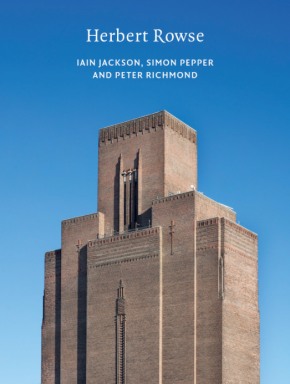Herbert Rowse
Herbert Rowse, Iain Jackson, Simon Pepper and Peter Richmond, Historic England, 2019, 149 pages, black and white and colour illustrations, softback.
The ability to think and act big has been a characteristic of Liverpool since the early 1700s, when it built the world’s first enclosed commercial wet dock. By the end of the 19th century it had become one of the wonders of Britain, with an architectural identity that surpassed all other provincial cities. The architect who did most to maintain that tradition in the 20th century was Herbert Rowse, whose monumental projects include India Buildings, Martin’s Bank, the Mersey Tunnel and the Philharmonic Hall, all built between 1923 and 1939. A star pupil of Charles Reilly at the Liverpool School of Architecture, Rowse stamped his mark on the city and, in spite of his success, never abandoned it for the metropolis, as most other architects of that period did. This enlightening volume in the Twentieth Century Architects series assesses the work of an architect who sought not to create a new architecture from scratch, but one that was inspired by historical precedent. Yet he also embraced aspects of modernism with masterly effect, such as with the massive ventilation towers for the Mersey Tunnel which enliven the city’s famous skyline.
This article originally appeared in IHBC's Context 164 (Page 54), published by The Institute of Historic Building Conservation in May 2020. It was written by Context’s reviews editor, Peter de Figueiredo.
--Institute of Historic Building Conservation
Related articles on Designing Buildings Wiki
IHBC NewsBlog
Old Sarum fire in listed (& disputed) WW1 Hangar - Wiltshire Council has sought legal advice after fire engulfed a listed First World War hangar that was embroiled in a lengthy planning dispute.
UK Antarctic Heritage Trust launches ‘Virtual Visit’ website area
The Trust calls on people to 'Immerse yourself in our heritage – Making Antarctica Accessible'
Southend Council pledge to force Kursaal owners to maintain building
The Council has pledged to use ‘every tool in the toolbox’ if urgent repairs are not carried out.
HE’s Research Magazine publishes a major study of the heritage of England’s suburbs
The article traces the long evolution of an internal programme to research 200 years of suburban growth
IHBC Context 183 Wellbeing and Heritage published
The issue explores issues at the intersection of heritage and wellbeing.
SAVE celebrates 50 years of campaigning 1975-2025
SAVE Britain’s Heritage has announced events across the country to celebrate bringing new life to remarkable buildings.
IHBC Annual School 2025 - Shrewsbury 12-14 June
Themed Heritage in Context – Value: Plan: Change, join in-person or online.
200th Anniversary Celebration of the Modern Railway Planned
The Stockton & Darlington Railway opened on September 27, 1825.
Competence Framework Launched for Sustainability in the Built Environment
The Construction Industry Council (CIC) and the Edge have jointly published the framework.
Historic England Launches Wellbeing Strategy for Heritage
Whether through visiting, volunteering, learning or creative practice, engaging with heritage can strengthen confidence, resilience, hope and social connections.















